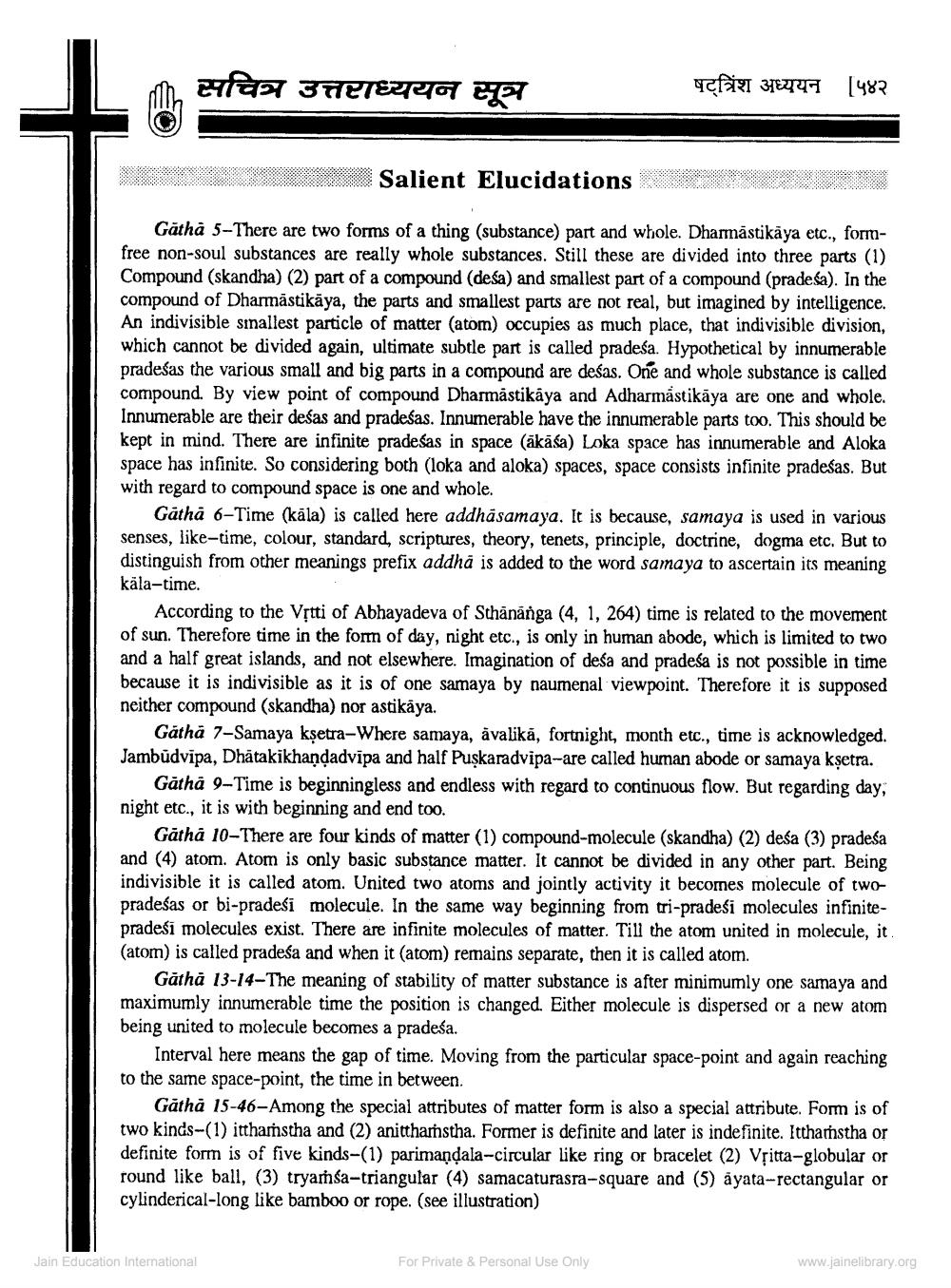________________
सचित्र उत्तराध्ययन सूत्र
Salient Elucidations
Gatha 5-There are two forms of a thing (substance) part and whole. Dhammastikaya etc., formfree non-soul substances are really whole substances. Still these are divided into three parts (1) Compound (skandha) (2) part of a compound (desa) and smallest part of a compound (pradea). In the compound of Dharmästikäya, the parts and smallest parts are not real, but imagined by intelligence. An indivisible smallest particle of matter (atom) occupies as much place, that indivisible division, which cannot be divided again, ultimate subtle part is called pradeda. Hypothetical by innumerable pradešas the various small and big parts in a compound are desas. One and whole substance is called compound. By view point of compound Dharmastikaya and Adharmastikaya are one and whole. Innumerable are their desas and pradeśas. Innumerable have the innumerable parts too. This should be kept in mind. There are infinite pradeśas in space (ākāśa) Loka space has innumerable and Aloka space has infinite. So considering both (loka and aloka) spaces, space consists infinite pradedas. But with regard to compound space is one and whole.
षट्त्रिंश अध्ययन [ ५४२
Gatha 6-Time (kála) is called here addhasamaya. It is because, samaya is used in various senses, like-time, colour, standard, scriptures, theory, tenets, principle, doctrine, dogma etc. But to distinguish from other meanings prefix addhá is added to the word samaya to ascertain its meaning käla-time.
According to the Vitti of Abhayadeva of Sthananga (4, 1, 264) time is related to the movement of sun. Therefore time in the form of day, night etc., is only in human abode, which is limited to two and a half great islands, and not elsewhere. Imagination of defa and pradeda is not possible in time because it is indivisible as it is of one samaya by naumenal viewpoint. Therefore it is supposed neither compound (skandha) nor astikaya.
Gatha 7-Samaya kṣetra-Where samaya, avalika, fortnight, month etc., time is acknowledged. Jambudvipa, Dhatakikhandadvipa and half Puşkaradvipa-are called human abode or samaya kşetra.
Gatha 9-Time is beginningless and endless with regard to continuous flow. But regarding day, night etc., it is with beginning and end too.
Gatha 10-There are four kinds of matter (1) compound-molecule (skandha) (2) deśa (3) pradeda and (4) atom. Atom is only basic substance matter. It cannot be divided in any other part. Being indivisible it is called atom. United two atoms and jointly activity it becomes molecule of twopradeśas or bi-pradesi molecule. In the same way beginning from tri-pradesi molecules infinitepradesi molecules exist. There are infinite molecules of matter. Till the atom united in molecule, it (atom) is called pradeda and when it (atom) remains separate, then it is called atom.
Gatha 13-14-The meaning of stability of matter substance is after minimumly one samaya and maximumly innumerable time the position is changed. Either molecule is dispersed or a new atom being united to molecule becomes a pradeśa.
Interval here means the gap of time. Moving from the particular space-point and again reaching to the same space-point, the time in between.
Gāthā 15-46-Among the special attributes of matter form is also a special attribute. Form is of two kinds-(1) itthamstha and (2) anitthamstha. Former is definite and later is indefinite. Itthamstha or definite form is of five kinds-(1) parimandala-circular like ring or bracelet (2) Vṛitta-globular or round like ball, (3) tryarhŝa-triangular (4) samacaturasra-square and (5) ayata-rectangular or cylinderical-long like bamboo or rope. (see illustration)
Jain Education International
For Private & Personal Use Only
www.jainelibrary.org




